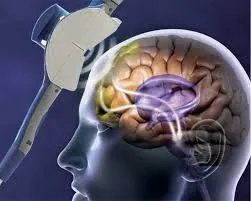
In recent years, Transcranial Magnetic Stimulation (TMS) has emerged as one of the most promising, non-invasive treatments for people struggling with depression and other mental health conditions. For those who haven’t found relief through traditional medication or therapy, TMS offers a scientifically proven, medication-free option that targets the brain directly.
But how exactly does TMS therapy work — and why are so many mental health professionals recommending it? Let’s explore the science behind this innovative treatment and how it can improve overall mental wellness.
What Is TMS Therapy?

Transcranial Magnetic Stimulation (TMS) is a form of neuromodulation therapy that uses gentle magnetic pulses to stimulate specific areas of the brain responsible for mood regulation — particularly the prefrontal cortex, which is often underactive in people with depression.
During a TMS session, a small electromagnetic coil is placed near the scalp. This coil sends magnetic pulses through the skull to activate neurons in targeted regions of the brain. Unlike electroconvulsive therapy (ECT), TMS does not require anesthesia or cause memory loss, and patients can resume normal activities immediately after each session.
The treatment is FDA-approved for major depressive disorder (MDD), and research continues to expand its applications for anxiety, obsessive-compulsive disorder (OCD), post-traumatic stress disorder (PTSD), and even chronic pain.
The Science: How TMS Affects the Brain
The human brain communicates through electrical signals — billions of neurons sending messages back and forth in complex patterns. When someone experiences depression or anxiety, this communication network becomes disrupted, leading to an imbalance in brain activity.
TMS therapy works by restoring healthy neural communication through magnetic stimulation. Here’s how:
- Magnetic pulses generate electric currents:
These currents safely penetrate the scalp and skull to reach specific brain areas. - Neurons are “retrained”:
The stimulation encourages underactive brain cells to fire normally, improving connectivity in regions linked to mood, emotion, and decision-making. - Long-term neuroplasticity:
Over time, repeated sessions promote neuroplasticity — the brain’s ability to form new connections and strengthen existing ones. This is why many patients experience lasting relief even after completing treatment.
Scientific studies have shown that after a full course of TMS, brain imaging often reveals more balanced activity patterns, similar to those of people without depression. Essentially, TMS helps the brain “reset” to healthier functioning.
What Happens During a TMS Session?
A typical TMS therapy session lasts about 20 to 40 minutes, depending on the device and treatment protocol. Here’s what patients can expect:
- Preparation:
You’ll sit in a comfortable chair while a trained clinician positions the magnetic coil over your head. - Mapping:
The provider locates the exact spot in your brain linked to mood control using mild test pulses. - Stimulation:
The device delivers a series of magnetic pulses — often described as a light tapping sensation on the scalp. You’ll be awake and alert throughout. - Post-session:
There’s no downtime. Most patients return to work or daily activities immediately after each session.
A standard TMS treatment plan typically involves five sessions per week for four to six weeks. Some people begin to notice mood improvements within two to three weeks, while others may need more sessions to feel the full effect.
Proven Benefits of TMS Therapy
TMS therapy has been studied extensively, and the results are compelling. According to multiple clinical trials and real-world studies, 60–70% of patients experience significant symptom improvement, while about one-third achieve full remission from depression.
Here are some of the most notable benefits:
1. Non-Invasive and Drug-Free
TMS doesn’t involve surgery or medication, making it an excellent option for individuals who cannot tolerate antidepressants due to side effects like weight gain, fatigue, or sexual dysfunction.
2. Minimal Side Effects
Most patients only report mild scalp discomfort or headache during the first few sessions, which typically resolves quickly. Unlike medications, TMS doesn’t cause systemic side effects.
3. Long-Lasting Relief
Because TMS promotes neuroplasticity, many patients continue to feel better for months or even years after completing treatment. Some return for maintenance sessions if symptoms reappear.
4. Enhances Cognitive Function
Studies have shown that TMS not only improves mood but can also boost focus, motivation, and cognitive clarity — benefits that contribute to overall mental wellness.
5. Compatible with Other Treatments
TMS can be safely combined with psychotherapy, medication, or lifestyle interventions like exercise and mindfulness for a comprehensive approach to mental health.
The Broader Impact on Mental Wellness
Beyond treating depression, researchers are exploring TMS therapy’s broader applications in mental health and brain health. Promising findings suggest that it can help with:
- Anxiety disorders: By calming overactive brain regions involved in fear and worry.
- PTSD: By improving regulation between emotional and memory-processing centers.
- Addiction recovery: Early studies indicate TMS may reduce cravings and improve self-control.
- Cognitive decline: Some research points to potential benefits for memory and attention in older adults.
As more studies confirm its versatility, TMS therapy is becoming a cornerstone of modern, science-based mental health care.
Real-World Accessibility and Growing Awareness
More clinics across the country are making TMS therapy accessible to those seeking advanced, evidence-based mental health treatment. For example, patients interested in Escondido California TMS Therapy can now find reputable centers offering personalized treatment plans, state-of-the-art equipment, and compassionate care guided by neuroscience.
This increased availability means more people can experience lasting relief — not just from symptoms, but from the feeling of hopelessness that often accompanies chronic mental health struggles.
Is TMS Therapy Right for You?
TMS therapy may be an excellent choice if:
- You’ve tried two or more antidepressants without sufficient improvement.
- You experience side effects that make medication intolerable.
- You want a non-invasive, evidence-based alternative.
- You’re committed to completing several weeks of regular treatment sessions.
Before starting, a qualified psychiatrist or TMS-certified provider will conduct a thorough evaluation to ensure it’s the right fit for your needs.
The Future of Mental Wellness
As our understanding of the brain deepens, treatments like TMS are reshaping how we approach mental health. Instead of merely managing symptoms, we’re now able to target the brain’s core mechanisms to promote healing and long-term balance.
TMS therapy represents a hopeful shift — one where science, technology, and compassionate care meet to empower people toward genuine wellness.
For many, it’s not just about overcoming depression; it’s about regaining clarity, energy, and the joy of living again.






Leave a Reply